When patients visit one of the best Gastroenterologists for chronic stomach discomfort, bloating, or nausea, they often expect to hear about ulcers, infections, or acid reflux. Yet sometimes, after multiple tests and endoscopies, everything appears normal. No ulcers, no gastritis, no structural damage. Still, the discomfort remains often daily. This puzzling condition, called functional dyspepsia, is one of the most complex and misunderstood disorders in gastroenterology, where the gut is fine, but it still feels unwell.
Functional dyspepsia (FD) sits at the intersection of digestion and emotion, a reminder that the stomach doesn’t just digest food; it also digests stress. The growing understanding of the gut-brain connection reveals that many “unexplained” gastric symptoms might not be about what’s happening in the stomach, but around it in the nervous system, the emotions, and the subconscious stress we carry.
When the Stomach Speaks but Tests Stay Silent
Patients with functional dyspepsia experience real, often severe symptoms: persistent upper abdominal pain, fullness after eating, early satiety, nausea, and sometimes even chest pressure. Yet, unlike ulcers or acid reflux, there are no visible abnormalities on scans or endoscopy.
What makes this condition unique is its subtlety. The stomach lining looks normal, but its sensory and motor functions are hypersensitive. The nerves that signal fullness or pain become overactive, sending exaggerated messages to the brain. A small meal might feel like a feast; a mild discomfort might feel like a burning ache.
It’s not “in the head,” as many patients are mistakenly told, it’s in the gut’s nervous system, which functions like a second brain. Known as the enteric nervous system, it contains over 100 million nerve cells that communicate constantly with the brain through the vagus nerve. When this communication goes haywire, symptoms appear even in the absence of physical disease.
The Gut-Brain Axis: A Two-Way Highway
The stomach and the brain share a complex, bidirectional relationship. When you feel anxious, your gut reacts with butterflies before an exam, nausea before a speech, or cramps during stress. But the connection works both ways. A disturbed gut can send distress signals back to the brain, leading to mood changes, irritability, and anxiety.
In functional dyspepsia, this feedback loop becomes exaggerated. Emotional stress amplifies gut sensitivity, and gut discomfort increases emotional distress, a self-perpetuating cycle that can last for years. Patients often say, “My stomach acts up when I’m tense,” without realizing that their body is literally mirroring their emotions.
Modern gastroenterology now recognizes the gut-brain axis as a core player in disorders like FD, IBS, and even chronic nausea. It’s not just about digestion; it’s about perception, emotion, and neural signaling.
Overstimulation: When the Gut and Mind Both Burn Out
Recent studies show that patients with functional dyspepsia have heightened brain responses to gut signals, especially in regions linked to emotion and pain processing. This phenomenon is called visceral hypersensitivity, the body’s version of sensory overload.
Just as loud sounds or flashing lights can overwhelm a sensitive nervous system, persistent internal sensations can overstimulate the brain’s pain centers. Over time, this creates a feedback loop where normal digestive sensations are perceived as distressing or painful.
This concept aligns closely with what’s described in this detailed article on overstimulation, anger, and panic attacks. Both conditions show how an overwhelmed nervous system whether from emotional triggers or gut signals can cause discomfort far beyond its original source. For dyspepsia patients, emotional stressors like deadlines, grief, or even subtle anxiety can feel like a meal that never sits right.
The gut becomes an emotional amplifier, not just a digestive organ. Every worry, every suppressed feeling, every hidden panic leaves a trace in the digestive tract.
Why Functional Dyspepsia Is So Hard to Treat
Traditional medications like antacids, proton pump inhibitors, and antibiotics (for H. pylori) often fail to relieve FD because they target the stomach but not the signals. The real issue lies in how the gut and brain communicate.
For example, some patients experience exaggerated gastric accommodation and the stomach’s inability to relax and expand after a meal. Others suffer from delayed emptying, where food lingers too long, leading to bloating and nausea. Yet these mechanical disruptions are worsened by stress, which tightens the muscles, restricts blood flow, and alters digestion hormones.
Even small life changes, a job shift, relationship tension, or loss of sleep can reignite symptoms. Patients often describe flare-ups during emotional turmoil, which reinforces the mind-body link. This makes FD a chronic relapsing condition that requires understanding, not just medication.
The Emotional Language of the Gut
There’s a poetic truth hidden in medicine: the gut expresses what the mind suppresses. Cultures worldwide intuitively recognize that we “stomach” problems, feel “gut-wrenched,” or have “butterflies.” These aren’t metaphors; they’re reflections of real neurochemical communication.
The enteric nervous system releases neurotransmitters like serotonin and dopamine, which also regulate mood. In fact, almost 90% of the body’s serotonin is produced in the gut. When gut signaling is disturbed, mood regulation suffers too. That’s why many FD patients also experience mild anxiety, irritability, or emotional fatigue.
Functional dyspepsia, therefore, isn’t only a gastrointestinal issue it’s a psychosomatic one. The discomfort in the stomach is often a physical echo of mental or emotional unrest.
Modern Approaches: Healing the Gut and the Mind Together
The best outcomes in functional dyspepsia come from integrative care. Gastroenterologists now collaborate with psychologists and neurologists to create dual-action treatment plans. Medications like low-dose antidepressants (not for depression but for nerve modulation) can help reset the gut’s sensitivity.
Cognitive Behavioral Therapy (CBT), gut-directed hypnotherapy, and mindfulness-based stress reduction have also shown strong results. They teach patients to reframe pain signals, reduce emotional triggers, and break the loop between gut distress and mental anxiety.
Diet modifications, smaller meals, avoiding caffeine, alcohol, and fatty foods can reduce triggers. But lasting relief often depends on emotional recalibration. Patients who learn relaxation techniques or journaling often report significant symptom improvement.
This approach humanizes medicine: instead of chasing symptoms, it seeks understanding. It acknowledges that the gut and the mind are partners, not separate entities.
When the Brain Finds Calm, the Gut Follows
The hope for functional dyspepsia lies not in eliminating every symptom, but in restoring harmony between body and mind. Once patients understand that their discomfort isn’t imagined that it’s a real physiological response amplified by emotional strain they start to heal differently.
The link between overstimulation and gut distress underscores the need for holistic care. Addressing both the emotional and physical aspects can reduce relapses and rebuild confidence in daily life. With proper guidance, patients learn to read their gut’s language to see it not as an enemy, but as an emotional compass that signals imbalance before the mind even realizes it.
Conclusion
Functional dyspepsia challenges the very definition of disease because it hides where medicine least expects in the communication between emotion and digestion. It shows how the stomach and the brain dance together, sometimes in sync, sometimes at odds.
By recognizing the signs of overstimulation and emotional triggers, doctors can move beyond symptom suppression toward real healing. For patients, understanding this connection is empowering. It means their suffering isn’t invisible, it’s simply complex.
The gut doesn’t just digest food; it processes experience, emotion, and energy. And sometimes, when life feels too heavy to swallow, it’s the gut that reminds us to slow down, breathe, and heal one calm meal, one calm thought at a time.








Leave a Reply